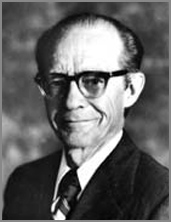D. Mark Hegsted
Year: October 24th, 2005
Location: Boston, Massachusetts
Interviewed by: Blackburn, Henry
Abstract
Mark Hegsted, major nutritional scientist and Father of the US Dietary Guidelines, is into his 90s, bright and full of wit and vinegar, and living in a pleasant retirement community outside Boston. We reminisced mainly about his palmy days in DC when he headed a joint committee of HEW and USDA and parlayed his knowledge and high civil service rank into the Dietary Guidelines for America. They were simpler guidelines, and as he said, should only have added eating fish a couple of times a week to be quite fine today, rather than complex fractionated pyramids requiring 95 pages of explication. He spoke of the need to simplify diet recommendations, to deal with one, not myriad populations, to address the population-wide as well as individual goals, and he marveled at the wide limits to human dietary adaptations, particularly for fat, protein, and calcium. Few people are more effective in government service than he was. He recounts anecdotes about Nutrition at Harvard, Fred Stare and George Mann. We could have used many visits, filled several interviews. (Henry Blackburn)
Quotes
NRC deliberations
The medical approach alone is an abdication of public responsibility.
We all tend to simplify to some degree whatever we find and like.
And I said to this friend, a nurse whose husband has Alzheimer’s: ‘Why in the hell are you giving him aspirin? Here’s a guy who is praying for a heart attack and you are giving him aspirin!’
Guidelines
They have [in the new Dietary Guidelines] pages after pages of how to adjust for body size and food intake and the simple solution is you put your dietary guidelines in percent of calories or per thousand calories. You know, bigger people eat more and need more. Other people eat less and need less. And that is about as good of an adjustment as you can make. And here they go to great big statistical tables… Even for kids, they eat the same diet as their parents do for all practical purposes.
It still amazes me that after 40 years of pushing calcium that there really isn’t any good evidence that it prevents osteoporosis.
I used to be pretty hot on pushing down the protein requirement, but I think maybe that is a mistake. I would say now 10 percent would be a reasonable low. I tried once, never published it, to keep some dogs alive at minimum protein levels and they went downhill
gradually.
[ed. For the new Guidelines] They’ve done the same thing that the Food and Nutrition Board did to the RDAs. They are unintelligible now and the new pyramid, hell, I think that’s a complete loss as far as I’m concerned. I think we did a hell of a good job on the Diet Guidelines at first. [ed. It revolutionized thinking and marketing and everything else.]
You know, they haven’t changed a heck of a lot in the 25 years since we proposed them. I think if I had to do it again I’d include eating fish a couple of times a week and I would include white bread with sugar when they said “eat less sugar;” they should have said “eat less sugar and higher refined cereals.” But, other than that, I think they are fine.
Why in the hell you need 95 pages to… I mean I am almost more upset whether they’re including dietary RDA.
And the next guy… who became Secretary [of Agriculture], had been the president of the American Meat Institute. I was told that he said they would approve the dietary guidelines over his dead body.
I always thought that the Framingham Study should have had a Nobel Prize. But there wasn’t any one individual.
Full Transcript Access
Full transcripts of interviews may be made available to those engaged with original materials for scholarly studies by contacting us.
